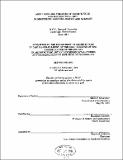| dc.contributor.advisor | Stanford Anderson. | en_US |
| dc.contributor.author | Schwarzer, Mitchell William | en_US |
| dc.coverage.spatial | e-au--- e-gx--- | |
| dc.date.accessioned | 2005-09-21T22:38:37Z | |
| dc.date.available | 2005-09-21T22:38:37Z | |
| dc.date.copyright | 1991 | en_US |
| dc.date.issued | 1991 | en_US |
| dc.identifier.uri | http://hdl.handle.net/1721.1/13470 | |
| dc.description | Thesis (Ph. D.)--Massachusetts Institute of Technology, Dept. of Architecture, 1991. | en_US |
| dc.description | Includes bibliographical references. | en_US |
| dc.description.abstract | This dissertation investigates changes that occurred in architectural culture in respect to conditions of modernity. Large-scale industrialization and urbanization caused dramatic ruptures with traditional social and economic hierarchies, forcing a reconceptualization of the theoretical constructs underlying architecture. During the course of the nineteenth century, writers on architecture took an active role in attempting to make sense of these changes. By the end of the century, the Viennese architect and theorist Adolf Loos set forth a critical project, often in confrontation with the views of others, to overcome the growing separation between the realms of reality and representation in design. The particular objective of this study is to situate Loos's texts within the intellectual context of Austrian and German writings on architecture and the practical arts. Such theories prefigure important expressions of modernism in the twentieth century. These writings also express a deep range of thoughts on the changing material and intellectual conditions affecting the visual arts. They exemplify a long series of attempts to create a unified identity for architecture in a world of new social relations and value systems. Despite amorphous conditions which favored social heterogeneity and difference, writers sought uniformity and an authoritative ground for architectural logic. The textual discourse in journals and books reveals the mental structures and preoccupations of writers in the grips of rapid transformation. On the practical level, new functional needs led to an expanded and diverse range of building types and plans. Further, industrial advances in construction technology and the use of new materials such as iron and glass challenged the applicability of traditional architectural forms for these new buildings. In turn, in a theoretical vein, debates on ethnic and historical genealogy and the epistemological or ontological foundations of all aspects of design turned architectural thought away from its former reliance on classicist paradigms of knowledge. It was also during the nineteenth century that historical consciousness structured architectural epistemology. As traditional guarantors of knowledge were questioned, the entirety of concepts defining architecture was transfigured. Laos and other writers sought to re-define the now hotly contested concepts of craft, art, architect, beauty, function, and truth. Conceptual production was frequently crafted through binary oppositions such as national/international or real/ideal. Loos's response to these developments was divided. On the one hand, he recognized cultural fragmentation and argued for the separate development of art and architecture. On the other hand, his vision of a design world dominated by the hand crafts and aristocratic values constitutes the Enlightenment vision of stability amidst progress. | en_US |
| dc.description.statementofresponsibility | [Mitchell Schwarzer]. | en_US |
| dc.format.extent | 2 v. (vi, 450 leaves) | en_US |
| dc.format.extent | 35627978 bytes | |
| dc.format.extent | 35627738 bytes | |
| dc.format.mimetype | application/pdf | |
| dc.format.mimetype | application/pdf | |
| dc.language.iso | eng | en_US |
| dc.publisher | Massachusetts Institute of Technology | en_US |
| dc.rights | M.I.T. theses are protected by copyright. They may be viewed from this source for any purpose, but reproduction or distribution in any format is prohibited without written permission. See provided URL for inquiries about permission. | en_US |
| dc.rights.uri | http://dspace.mit.edu/handle/1721.1/7582 | |
| dc.subject | Architecture | en_US |
| dc.subject.lcsh | Loos, Adolf, 1870-1933 | en_US |
| dc.title | Adolf Loos and theories of architecture and the practical arts in nineteenth century Austria and Germany | en_US |
| dc.type | Thesis | en_US |
| dc.description.degree | Ph.D. | en_US |
| dc.contributor.department | Massachusetts Institute of Technology. Department of Architecture | |
| dc.identifier.oclc | 25696827 | en_US |
